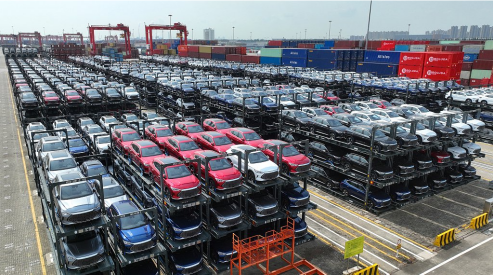
At the end of April this year, a ro-ro ship loaded with 3,439 new energy vehicles "BYD Pathfinder 1" sailed away from the Guangdong Shenzhen-Shantou Xiaomo International Logistics Port, set off to South America, Brazil and other regions, to open its ocean journey.
At a time when China's automobile exports are increasing day by day, the high transportation cost and the potential of overseas markets pull each other, pushing a number of independent brands to invest in shipbuilding across the track, including SAIC, BYD, Chery and many other automobile enterprises have laid out the ro-ro business.
According to the export destination and export volume, the lower freight rate of water transport often becomes the preferred mode of transportation of independent brands exported to South America, Europe, the Middle East, and pry the North American market by entering South America. However, the current road to export new energy vehicles in the Americas is full of challenges.
Since January 2024, Brazil, an important market for electric vehicles in South America, will restart import tariffs on new energy vehicles, covering pure electric vehicles, plug-in hybrid vehicles and hybrid vehicles. The United States in North America, on the other hand, introduced the Inflation Reduction Act in 2022, which stipulates that U.S. consumers can get up to $7,500 in subsidies for purchasing compliant clean-energy vehicles, with the exception of vehicles using battery components made in China.
Shipbuilding "Transportation to Overseas"
"An ordinary car from China's ports to Europe or North America need to pay about 2,000 ~ 5,000 U.S. dollars ranging from the cost of shipping, which is only the base cost, but also need to add the destination country's tariffs, taxes, insurance costs and other additional costs." The person in charge of an international logistics company told reporters that in the past three years, as China's automobile exports are getting bigger and bigger, the cost of sea transportation has also risen.
The head of a logistics company affiliated with a car company said that the highest charter rate of the ship this year has exceeded 100,000 U.S. dollars, compared with 2021's 20,000 U.S. dollars charter rate rose five times. And the cost of ocean transportation for a ro-ro ship at its most expensive is equivalent to the cost of producing a car. Data from VesselsValue, a shipping business data provider, shows that the current ro-ro charter cost for 6,500 spaces has reached $123,500 per day.
The rapidly increasing demand for exports from Chinese car companies, fueled by new energy vehicles, has also led to a steady climb in ocean freight rates. Data from the China Association of Automobile Manufacturers (CAAM) shows that car exports have increased nearly fourfold over the past three years. In the first quarter of this year, 1.324 million cars were exported, an increase of more than 30% year-on-year. Data from the General Administration of Customs show that in the first quarter of this year, the cumulative total import and export of automotive goods in the country amounted to 68.29 billion U.S. dollars, an increase of 5.5% year-on-year. Among them, imports amounted to 15.73 billion U.S. dollars, down 11.5% year-on-year; exports amounted to 52.56 billion U.S. dollars, up 11.9% year-on-year.
It is worth mentioning that, although in the export volume, China has surpassed Japan to leapfrog the world's first exporting country, but in the field of export transportation in the important ro-ro ship, Japan currently has more than 300 ro-ro ships, accounting for 38.88% of the world, is the world's largest ro-ro ship capacity of the country; and mainland China ro-ro ships are still less than 40, accounting for nearly 5% of the world, a smaller share. At the same time, Japan, South Korea and other countries with many years of export experience has formed a relatively stable shipping costs.
Based on the above factors, in order to ensure the stability of the supply chain to the sea, control the "sea" costs, etc., a number of car companies personally "field" cross-border shipbuilding. At present, most of the domestic automobile enterprises realize the long-term large-volume vehicle "going to sea" business by renting transportation vessels or building their own fleet in two modes.
In 2022, BYD invested more than 500 million U.S. dollars, according to the average price of a single ship 87 million U.S. dollars to build the first batch of six car ro-ro ships, plus two option orders, BYD in the next two years will have a fleet of at least 8 ro-ro ships; Chery Automobile joint Wuhu Shipyard to build a car transporter shipbuilding base in Weihai, and the beginning of 2023 to buy three new ro-ro ships; GAC Group's Guangzhou Automobile Trade Guangzhou Automobile Trading, a subsidiary of GAC Group, has invested with China Merchants Shipping to establish Guangzhou Merchants Roll-on Roll-off Transportation Company. In addition, the SAIC Group set up Anji Logistics has nine special foreign trade ships, all of which are in the mode of self-ship and self-management.
After trying to find ways to control the high cost of shipping, domestic car companies will further focus their strategic attention on the American market.
Written by Mario
